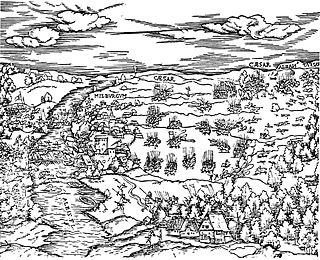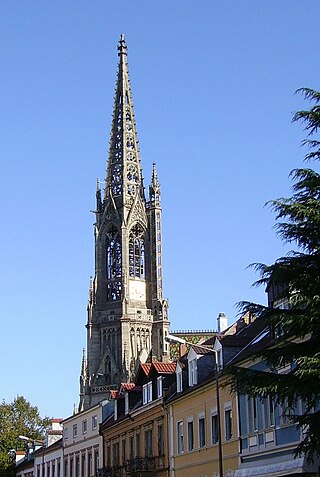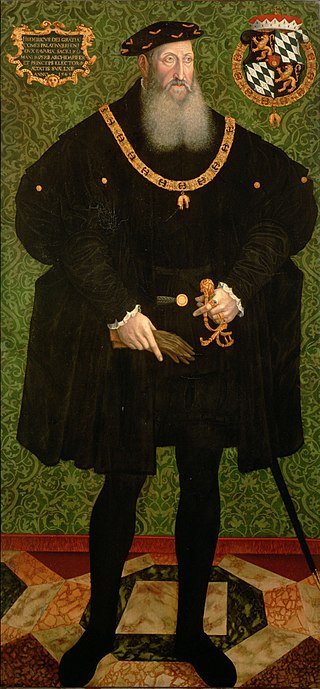The Diets of Nuremberg, also called the Imperial Diets of Nuremberg, took place at different times between the Middle Ages and the 17th century.

Maximilian II was Holy Roman Emperor from 1564 until his death in 1576. A member of the Austrian House of Habsburg, he was crowned King of Bohemia in Prague on 14 May 1562 and elected King of Germany on 24 November 1562. On 8 September 1563 he was crowned King of Hungary and Croatia in the Hungarian capital Pressburg. On 25 July 1564 he succeeded his father Ferdinand I as ruler of the Holy Roman Empire.

Ferdinand I was Holy Roman Emperor from 1556, King of Bohemia, Hungary, and Croatia from 1526, and Archduke of Austria from 1521 until his death in 1564. Before his accession as Emperor, he ruled the Austrian hereditary lands of the Habsburgs in the name of his elder brother, Charles V, Holy Roman Emperor. Also, he often served as Charles' representative in the Holy Roman Empire and developed encouraging relationships with German princes. In addition, Ferdinand also developed valuable relationships with the German banking house of Jakob Fugger and the Catalan bank, Banca Palenzuela Levi Kahana.

The Schmalkaldic League was a military alliance of Lutheran princes within the Holy Roman Empire during the mid-16th century.

Philip I, Landgrave of Hesse, nicknamed der Großmütige, was a German nobleman and champion of the Protestant Reformation, notable for being one of the most important of the early Protestant rulers in Germany.

The Battle of Mühlberg took place near Mühlberg in the Electorate of Saxony in 1547, during the Schmalkaldic War. The Catholic princes of the Holy Roman Empire led by the Holy Roman Emperor Charles V decisively defeated the Lutheran Schmalkaldic League of Protestant princes under the command of Elector John Frederick I of Saxony and Landgrave Philip I of Hesse.

The Schmalkaldic War was the short period of violence from 1546 until 1547 between the forces of Emperor Charles V of the Holy Roman Empire, commanded by the Duke of Alba and the Duke of Saxony, and the Lutheran Schmalkaldic League within the domains of the Holy Roman Empire.

The Diet of Augsburg were the meetings of the Imperial Diet of the Holy Roman Empire held in the German city of Augsburg. Both an Imperial City and the residence of the Augsburg prince-bishops, the town had hosted the Estates in many such sessions since the 10th century. In 1282, the diet of Augsburg assigned the control of Austria to the House of Habsburg. In the 16th century, twelve of thirty-five imperial diets were held in Augsburg, a result of the close financial relationship between the Augsburg-based banking families such as the Fugger and the reigning Habsburg emperors, particularly Maximilian I and his grandson Charles V. Nevertheless, the meetings of 1518, 1530, 1547/48 and 1555, during the Reformation and the ensuing religious war between the Catholic emperor and the Protestant Schmalkaldic League, are especially noteworthy. With the Peace of Augsburg, the cuius regio, eius religio principle let each prince decide the religion of his subjects and inhabitants who could not conform could leave.

John Frederick I, called the Magnanimous, was the Elector of Saxony (1532–1547) and head of the Schmalkaldic League.

The Edict of Restitution was proclaimed by Ferdinand II, Holy Roman Emperor in Vienna, on 6 March 1629, eleven years into the Thirty Years' War. Following Catholic military successes, Ferdinand hoped to restore control of land to that specified in the Peace of Augsburg (1555). That treaty's "Ecclesiastical Reservation" had prohibited further secularization of lands held by the Catholic church after 1555, disallowing any transfer of such lands to Protestant control. However, as the Holy Roman Empire descended into the Thirty Years' War, weak emperors had been unable to enforce this provision against Protestant encroachments.

JacobSturm von Sturmeck was a German statesman, one of the preeminent promoters of the Protestant Reformation in Germany.

On April 19, 1529, six princes and representatives of 14 Imperial Free Cities petitioned the Imperial Diet at Speyer against an imperial ban of Martin Luther, as well as the proscription of his works and teachings, and called for the unhindered spread of the evangelical faith.
The Diet of Speyer or the Diet of Spires was an Imperial Diet of the Holy Roman Empire in 1526 in the Imperial City of Speyer in present-day Germany. The Diet's ambiguous edict resulted in a temporary suspension of the Edict of Worms and aided the expansion of Protestantism. Those results were repudiated in the Diet of Speyer (1529).

Frederick II, Count Palatine of the Rhine, also Frederick the Wise, a member of the Wittelsbach dynasty, was Prince-elector of the Palatinate from 1544 to 1556.

Otto Truchsess von Waldburg was Prince-Bishop of Augsburg from 1543 until his death and a Cardinal of the Catholic Church.

Wolfgang, Prince of Anhalt-Köthen, was a German prince of the House of Ascania and ruler of the principality of Anhalt-Köthen. He was one of the earliest Protestant rulers in the Holy Roman Empire.

The German-speaking states of the early modern period were divided politically and religiously. Religious tensions between the states comprising the Holy Roman Empire had existed during the preceding period of the Late Middle Ages —notably erupting in Bohemia with the Hussite Wars (1419–1434). However, the defining religious movement of this period, the Reformation, would result in unprecedented levels of violence and political upheaval for the region.

The Augsburg Confession, also known as the Augustan Confession or the Augustana from its Latin name, Confessio Augustana, is the primary confession of faith of the Lutheran Church and one of the most important documents of the Protestant Reformation. The Augsburg Confession was written in both German and Latin and was presented by a number of German rulers and free-cities at the Diet of Augsburg on 25 June 1530.

The Imperial Diet was the deliberative body of the Holy Roman Empire. It was not a legislative body in the contemporary sense; its members envisioned it more like a central forum where it was more important to negotiate than to decide.

Johann, known as Johann the Steadfast or Johann the Constant, was Elector of Saxony from 1525 until 1532 from the House of Wettin.
















